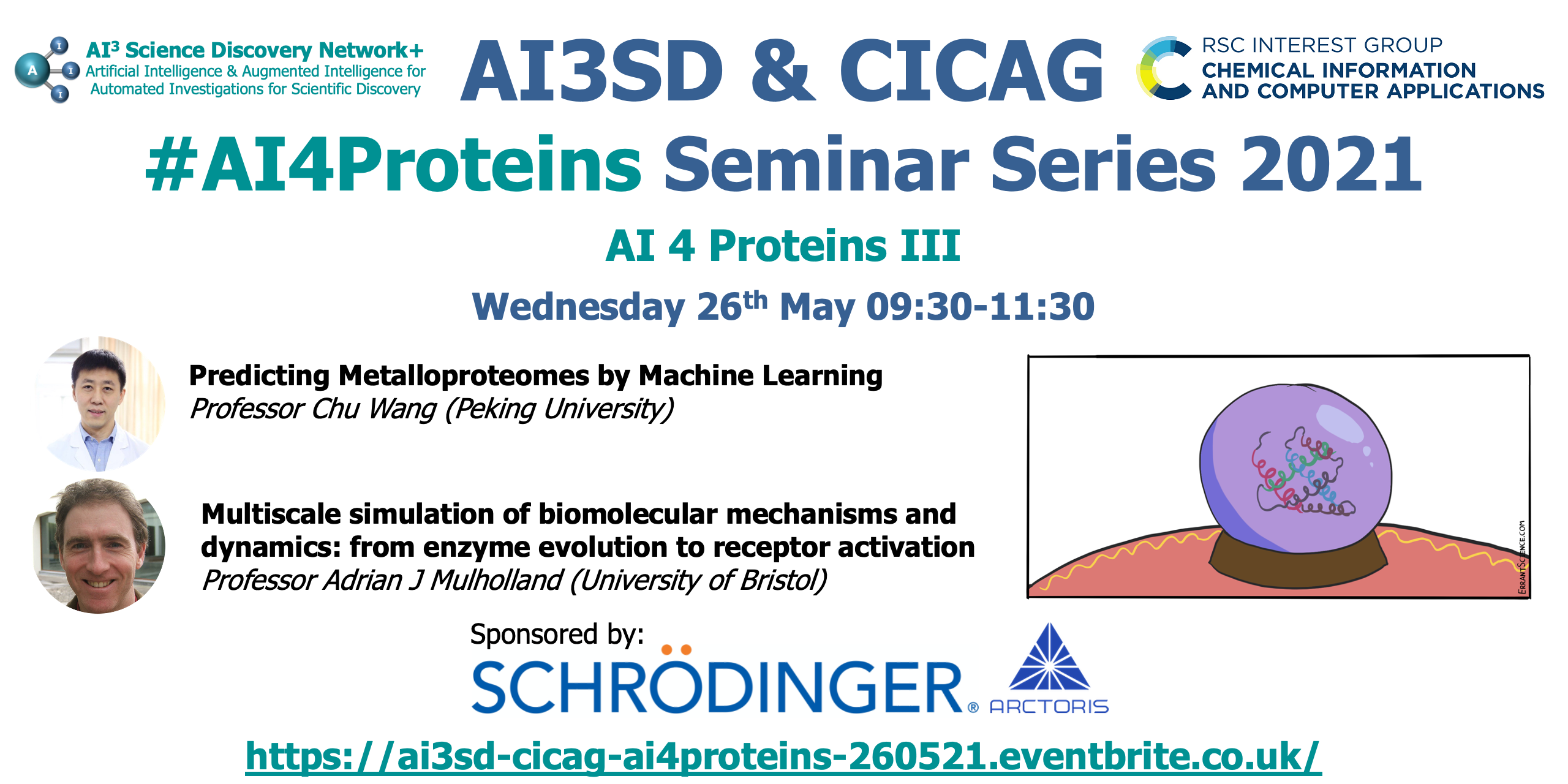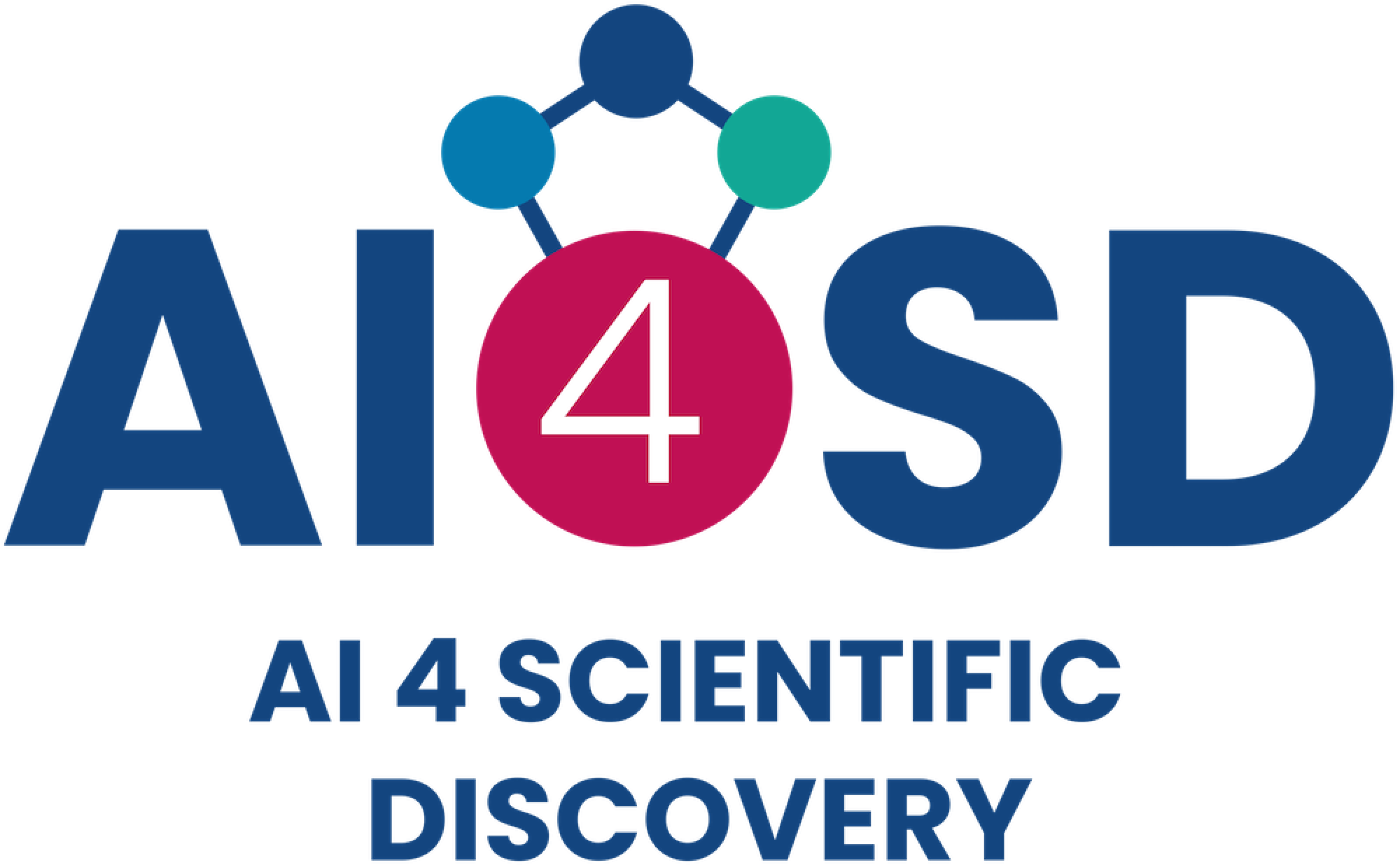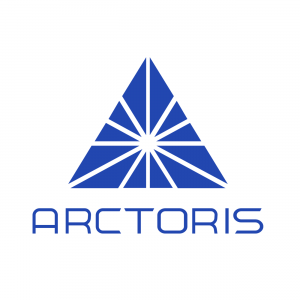
- This event has passed.
26/05/2021 – AI3SD & RSC-CICAG AI 4 Proteins III
26th May 2021 @ 9:30 am - 11:30 am
Free
Eventbrite Link: https://ai3sd-cicag-ai4proteins-260521.eventbrite.co.uk
Description:
This seminar forms part of the AI3SD/RSC-CICAG AI 4 Proteins Seminar Series. This seminar will be run via zoom, when you register on Eventbrite you will receive a zoom registration email alongside your standard Eventbrite registration email. Where speakers have given permission to be recorded, their talks will be made available on our AI3SD YouTube Channel.
Agenda
- 09:30-10:20: Predicting Metalloproteomes by Machine Learning – Professor Chu Wang (Peking University)
- 10:20-10:40: Coffee Break
- 10:40-11:30: Multiscale simulation of biomolecular mechanisms and dynamics: from enzyme evolution to receptor activation – Professor Adrian J Mulholland (University of Bristol)
Abstracts & Speaker Bios
- Predicting Metalloproteomes by Machine Learning – Professor Chu Wang: Metal ions play various important biological functions in proteins, including structural maintenance, molecular recognition, and catalysis. In this talk, I will present our work on developing computational methods to systematically predict metal-binding proteins and sites in proteomes. Our method, named “MetalNet”, combined a powerful machine learning model and the graph theory to predict known and novel metal-binding sites in proteomes from prokaryotic and eukaryotic species. We biochemically validated a novel prediction without any structural or sequence homology to known metalloproteins. MetalNet will provide a unique and enabling tool for interrogating the hidden metalloproteome.
Bio: Chu Wang received Ph.D. in 2007 from University of Washington under the guidance of Professor David Baker, training in the area of computational protein structural prediction and design. He then worked as a postdoctoral fellow with Professor Benjamin Cravatt at The Scripps Research Institute, Lo Jolla, and developed multiple chemical proteomic methods to profile reactive cysteines and modifications in proteomes. In 2014, he joined Peking University as a tenure-track assistant professor of Chemical Biology and was promoted to the full professor in 2020. His research interest is to develop chemical and computational proteomics methods to enable quantitative profiling of functional enzymes, protein post-translational modifications as well as protein-ligand interactions in proteomes. - Multiscale simulation of biomolecular mechanisms and dynamics: from enzyme evolution to receptor activation – Professor Adrian J Mulholland:Simulations are revealing detailed mechanisms of biomolecular systems and functionally relevant dynamics, and contributing to enzyme design. Biomolecular simulations can be used as computational ‘assays’ of biological activity, e.g. to predict drug resistance or the effects of mutation. Molecular simulation methods of various types are now capable of modelling processes ranging from biochemical reactions to membrane dynamics, and offer increasing predictive power. Recently, this has included identifying key features of SARS-CoV-2 proteins. Molecular dynamics (MD) simulations on long timescales can model substrate binding, and reveal dynamical changes associated with thermoadaptation and directed evolution of enzyme catalytic activity. MD simulations can calculate thermodynamic properties such as activation heat capacities. Increasingly, simulations are contributing to the design and engineering of natural enzymes and de novo biocatalysts. Interactive MD simulation in virtual reality allows direct manipulation of biological macromolecules, going beyond mere visualization to allow e.g. fully flexible docking of drugs into protein targets such as the SARS-CoV-2 main protease. Groups of researchers can work together in the same virtual environment. Mechanisms of signal transduction in receptors can be studied by a combination of equilibrium and nonequilibrium MD simulations, e.g. identifying a general mechanism of signal propagation in nicotinic acetylcholine receptors. Different types of application (e.g. ranging from chemical reactions to signal transduction) require different levels of treatment, which can be combined in multiscale models to tackle a range of time- and length-scales, e.g. to study drug metabolism by cytochrome P450 enzymes combining coarse-grained and atomistic MD and QM/MM methods. By coupling together different levels of description, multiscale methods can address e.g. how chemical changes in individual molecules cause changes at larger scales. QM/MM methods are an archetype of multiscale methods in biochemistry and can be used for modelling transition states and reaction intermediates, to identify catalytic interactions, and to analyse determinants of reactivity. QM/MM modelling can identify mechanisms of covalent inhibition and predict the activity of bacterial enzymes against antibiotics.
References
‘Evolution of dynamical networks enhances catalysis in a designer enzyme’ H.A. Bunzel et al. Nature Chemistry, in press (2021). https://www.biorxiv.org/content/10.1101/2020.08.21.260885v1
‘Designing better enzymes: Insights from directed evolution’ HA Bunzel, JLR Anderson, AJ Mulholland Current Opinion in Structural Biology 67, 212-218 (2021)
‘Allosteric communication in class A β-lactamases occurs via cooperative coupling of loop dynamics’ I. Galdadas et al. eLife 10:e66567 DOI: 10.7554/eLife.66567 (2021)
‘Mechanism of covalent binding of ibrutinib to Bruton’s tyrosine kinase revealed by QM/MM calculations’ A Voice et al. Chemical Science https://doi.org/10.1039/D0SC06122K (2021)
‘Interactive Molecular Dynamics in Virtual Reality Is an Effective Tool for Flexible Substrate and Inhibitor Docking to the SARS-CoV-2 Main Protease’ HM Deeks et al. Journal of Chemical Information and Modeling 60, 5803-5814 (2020) https://doi.org/10.1021/acs.jcim.0c01030
‘Molecular Simulations suggest Vitamins, Retinoids and Steroids as Ligands of the Free Fatty Acid Pocket of the SARS-CoV-2 Spike Protein’ D.K. Shoemark et al. 133, 7174-7186 (2021)
‘Biomolecular Simulations in the Time of COVID-19, and After’ R.E. Amaro & A.J. Mulholland Computing in Science & Engineering 22, 30-36 (2020) DOI: 10.1109/MCSE.2020.3024155
Bio: Adrian Mulholland is a Professor of Chemistry and School Research Director in the School of Chemistry at the University of Bristol. His research focuses on the investigation of mechanisms of enzyme catalysis, and biomolecular structure and function more generally, by computational modelling and simulation. He was awarded the 2020 John Meurig Thomas Medal ‘for outstanding and innovative work in catalytic science’ and is an ERC Advanced Grant holder.

